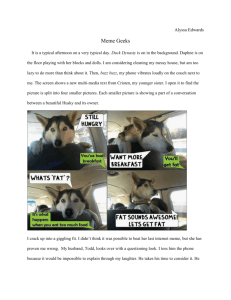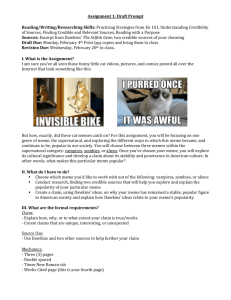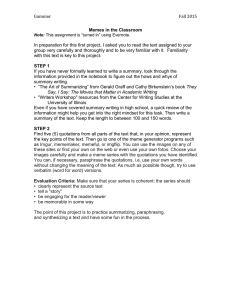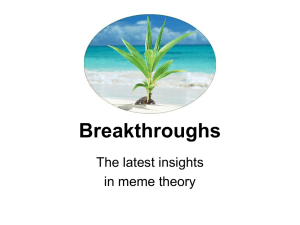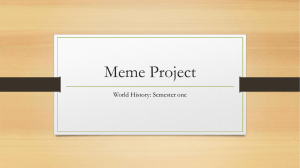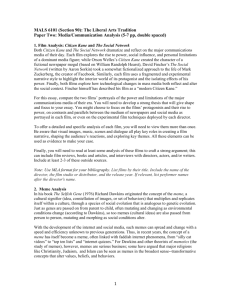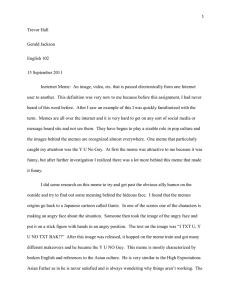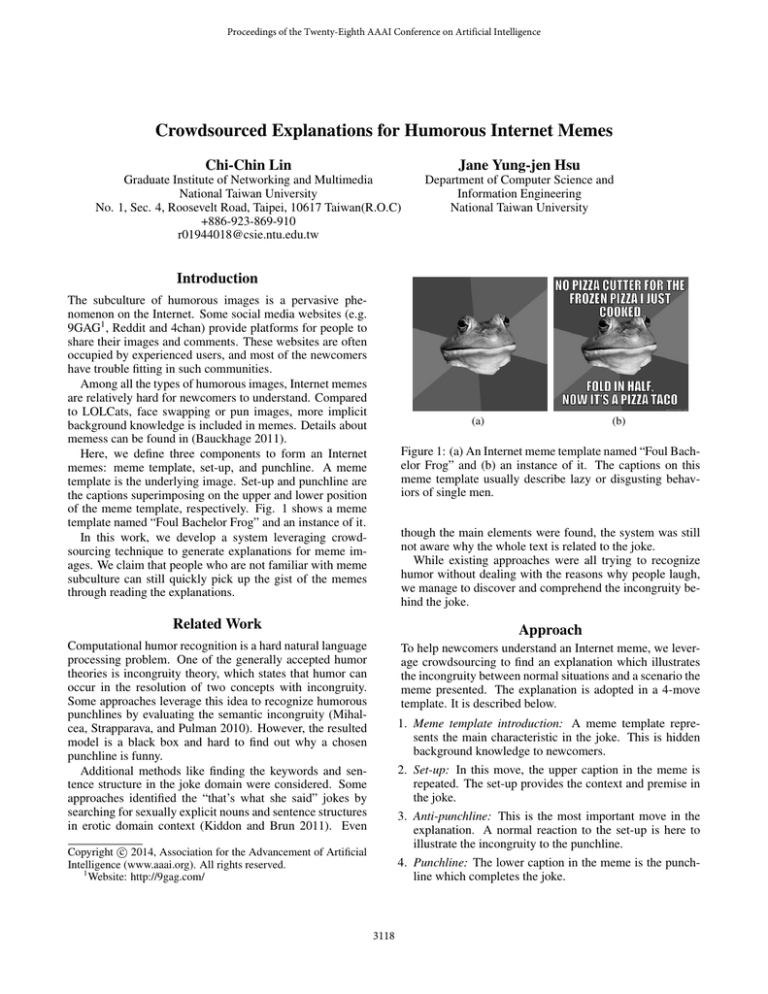
Proceedings of the Twenty-Eighth AAAI Conference on Artificial Intelligence
Crowdsourced Explanations for Humorous Internet Memes
Chi-Chin Lin
Graduate Institute of Networking and Multimedia
National Taiwan University
No. 1, Sec. 4, Roosevelt Road, Taipei, 10617 Taiwan(R.O.C)
+886-923-869-910
r01944018@csie.ntu.edu.tw
Jane Yung-jen Hsu
Department of Computer Science and
Information Engineering
National Taiwan University
Introduction
The subculture of humorous images is a pervasive phenomenon on the Internet. Some social media websites (e.g.
9GAG1 , Reddit and 4chan) provide platforms for people to
share their images and comments. These websites are often
occupied by experienced users, and most of the newcomers
have trouble fitting in such communities.
Among all the types of humorous images, Internet memes
are relatively hard for newcomers to understand. Compared
to LOLCats, face swapping or pun images, more implicit
background knowledge is included in memes. Details about
memess can be found in (Bauckhage 2011).
Here, we define three components to form an Internet
memes: meme template, set-up, and punchline. A meme
template is the underlying image. Set-up and punchline are
the captions superimposing on the upper and lower position
of the meme template, respectively. Fig. 1 shows a meme
template named “Foul Bachelor Frog” and an instance of it.
In this work, we develop a system leveraging crowdsourcing technique to generate explanations for meme images. We claim that people who are not familiar with meme
subculture can still quickly pick up the gist of the memes
through reading the explanations.
(a)
(b)
Figure 1: (a) An Internet meme template named “Foul Bachelor Frog” and (b) an instance of it. The captions on this
meme template usually describe lazy or disgusting behaviors of single men.
though the main elements were found, the system was still
not aware why the whole text is related to the joke.
While existing approaches were all trying to recognize
humor without dealing with the reasons why people laugh,
we manage to discover and comprehend the incongruity behind the joke.
Related Work
Approach
Computational humor recognition is a hard natural language
processing problem. One of the generally accepted humor
theories is incongruity theory, which states that humor can
occur in the resolution of two concepts with incongruity.
Some approaches leverage this idea to recognize humorous
punchlines by evaluating the semantic incongruity (Mihalcea, Strapparava, and Pulman 2010). However, the resulted
model is a black box and hard to find out why a chosen
punchline is funny.
Additional methods like finding the keywords and sentence structure in the joke domain were considered. Some
approaches identified the “that’s what she said” jokes by
searching for sexually explicit nouns and sentence structures
in erotic domain context (Kiddon and Brun 2011). Even
To help newcomers understand an Internet meme, we leverage crowdsourcing to find an explanation which illustrates
the incongruity between normal situations and a scenario the
meme presented. The explanation is adopted in a 4-move
template. It is described below.
1. Meme template introduction: A meme template represents the main characteristic in the joke. This is hidden
background knowledge to newcomers.
2. Set-up: In this move, the upper caption in the meme is
repeated. The set-up provides the context and premise in
the joke.
3. Anti-punchline: This is the most important move in the
explanation. A normal reaction to the set-up is here to
illustrate the incongruity to the punchline.
c 2014, Association for the Advancement of Artificial
Copyright Intelligence (www.aaai.org). All rights reserved.
1
Website: http://9gag.com/
4. Punchline: The lower caption in the meme is the punchline which completes the joke.
3118
The first move can be automatically achieved by recognizing the meme template by digital image processing techniques and retrieving introductions from online resources
like Know Your Meme2 . In addition, we can optical character recognition algorithms to extract captions in the memes
to generate the second and fourth move.
You have no pizza cutter for the frozen
pizza you just cooked.
Foul bachelor
Normal person
• buy one
• try to find any substitute
• pick up the whole thing and
eat it
• other:
Semantic Script Theory of Humor
Semantic Script Theory of Humor (SSTH) was proposed
to implement incongruity theory (Raskin 1985). SSTH
claimed that a text can carry a single joke if (1) the text is
fully or partially compatible with two different scripts and
(2) the two scripts are opposite.
According to SSTH, the anti-punchline in the 4-move explanation is the alternative script opposite against the original punchline. The trait basis of the oppositeness is determined by the characteristic in the meme template.
• just fold it in half,
and now it’s a pizza
taco.
Figure 2: The selection task for Fig. 1(b) in our pilot study.
After 2 workers agree “try to find any substitute” to be the
best opposite reaction, it is the anti-punchline. Therefore,
the 4-move explanation is completed and shown below.
Humor Tasks Design
We design 2 humor tasks to find the anti-punchline. The first
task is to collect anti-punchline candidates while the second
task is to select the best anti-punchline out of the candidates.
Task 1: collecting anti-punchline candidates. The workers
are asked to imagine themselves in given situations and fill
in their reasonable reactions. Each given situation is the setup caption that is transformed into a first-person pronouns
sentence and we collect 3 reactions for the selection task.
Task 2: selecting the best anti-punchline from the candidates. The workers are asked to choose the best opposite
reaction against the punchline in respect to given trait basis.
The trait basis is determined by the meme template and the
provided choices are from the collection task. When two
workers agree with a specific reaction, it will become the
anti-punchline in the explanation.
1. The background image is called “Foul Bachelor Frog”.
The images captions often depict lazy, disgusting and hedonistic behaviors associated with single men.
2. The upper caption said that he has no pizza cutter for the
frozen pizza he just cooked.
3. We may expect that he would try to find a substitution.
4. However, in the lower caption, it turned out that he just
fold it in half, and now it’s a pizza taco.
Conclusion & Future Work
Humorous Internet memes can be seen in many image-based
online forums. However, steep learning curves are observed
for the newcomers to fit in this subculture. In this paper, we
propose a template-based explanation approach to extract
the incongruity in memes. With crowdsourcing technique,
we are able to generate such explanations. In our pilot study,
acceptable explanations for 5 unique memes are generated.
For further research in artificial intelligence, developing
a computational system to produce explanations for general
jokes using our explanations as training data is possible.
Pilot Study
Since 9GAG is one of the most popular websites for funny
images, we chose it as our meme source and crawl 39447
posts from it. From the posts, we automatically recognize
3051 memes in 38 unique meme templates. Among them, 5
memes are randomly selected and used in our pilot study3 .
After we went through the task process and received 30
responses of the tasks, we generated explanations for each
of the 5 memes. As Fig. 1(b) is chosen in our pilot test, the
following describes how we generate an explanation for it.
The collection task generated from the set-up caption in
Fig. 1(b) will be:
References
Bauckhage, C. 2011. Insights into internet memes. In
Adamic, L. A.; Baeza-Yates, R. A.; and Counts, S., eds.,
ICWSM. The AAAI Press.
Kiddon, C., and Brun, Y. 2011. That’s what she said: Double
entendre identification. In Proceedings of the 49th Annual
Meeting of the Association for Computational Linguistics,
89–94.
Mihalcea, R.; Strapparava, C.; and Pulman, S. 2010. Computational models for incongruity detection in humour. In
Computational Linguistics and Intelligent Text Processing,
volume 6008. Springer Berlin Heidelberg. 364–374.
Raskin, V. 1985. Semantic Mechanisms of Humor. Studies
in Linguistics and Philosophy. D. Reidel.
You are a normal person, and you have no pizza cutter for
the frozen pizza you just cooked.
Your reasonable reaction would be:
After receiving 3 responses from the collection task, we
can continue publish the selection task shown in Fig. 2.
2
Website: http://knowyourmeme.com/
Complete datasets and results are in http://www.csie.ntu.edu.
tw/∼r01944018/meme-explanations/
3
3119

